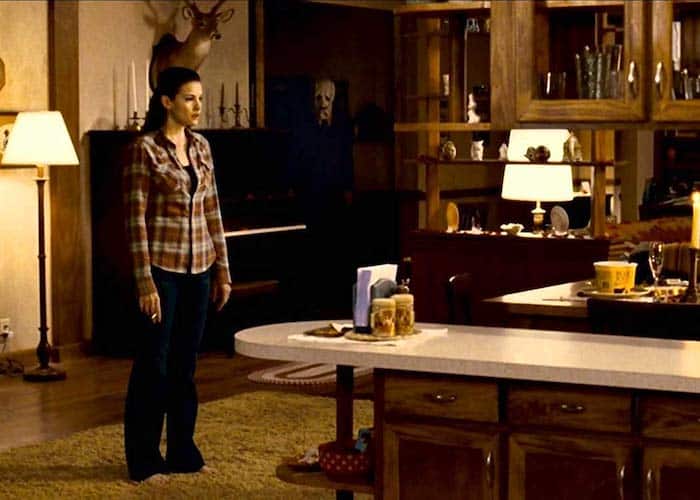As a couple is in the midst of being violently murdered, they ask the three masked strangers standing over them why they’re doing this. The answer? “Because you were home.” Bryan Bertino’s 2008 horror feature The Strangers is a tight, nihilistic film about how sometimes people kill just to kill. There is no rhyme or reason to it; there is only violence and the desire to torture and hurt.
Kristen and James head to his family’s country house in the middle of nowhere after a wedding. There, they try to settle in for the night only to be disturbed by a group of faceless tormenters. They bang on doors, scratch windows, and taunt the couple. They sneak in and out of the house, destroy cell phones, and push the couple to their absolute limit. Their ultimate goal? To toy with Kristen and James like sadistic predators until deciding it is time for the couple to die.
The film’s most terrifying shot marks the beginning of The Strangers’ horror. Kristen stands in the living room looking around. Behind her, out of the shadows, emerges a masked man. He stands silently behind her as she is unknowingly being watched. The shot is a perfect example of letting the audience in on a secret that builds terror and suspense. It is the opposite of a jumpscare but perhaps all the more terrifying: we know what is going to unfold, and we can’t do anything to stop it.
In not seeing a film’s killer, we are more closely aligned with the characters. We do not know any more than they do and we are on a figurative level playing field. Their scares are our scares. We are not privy to any other information and can view the events on screen guilt-free. In a shot like this, we know where the killer is and what he looks like. We want to shout at the screen and tell her to turn around. Obviously we cannot warn the characters on screen, but the impulse is still there. Instead, we must watch helplessly as acts of violence ensue. This is a shot that makes the spectator aware of their viewing position. We are no longer just passively watching violence but are instead implicated in whatever the villain may do next.
However, our expectations are subverted as the strange man doesn’t attack her. He instead vanishes as quickly as he appears. Kristen is not aware he was ever there, but we are. This ups the tension for the audience; we now will be searching the screen for a masked stranger at all times. It does not matter if the protagonist sees the bad guy in The Strangers; what matters is if the spectator can spot him, which drives up the film’s tension even more.
This shot also establishes the scare tactics for the rest of the film, as well as its prevalent nihilism. All three masked strangers are silent stalkers, slipping through the darkness and appearing to watch their victims without necessarily attacking. They are not flashy villains that make noise to announce their presence. The only reason Kristen or James knows they are around is that the strangers let them know. These three people are in complete control of the situation. They operate in stealth, which this shot effectively establishes. These villains cannot be confronted or killed like most horror movie villains. There is no trick to their madness and no way to prevent them from getting inside. No locks can keep them out.
Finally, the shot creates different levels of space, which again adds to its horror. Kristen stands in the shot’s foreground and is well-lit. The light makes this seem like a safe haven from whatever is unfolding outside. However, the background quickly becomes a focal point as the darkness is broken by the bright white mask. It makes this relatively small domestic space feel huge, a massive place full of hiding spots that could be concealing one of these monsters. Locks, doors, and windows do not keep things out but are instead permeable barriers that can easily be shattered. These layers of space shift the domestic space from a place of comfort to a place of fear; it has been infiltrated by a threatening force.
In the infiltration of the domestic space, The Strangers marks itself as an important piece of post-9/11 horror. The horror films that came after the terrorist attacks of September 11, 2001, try to grapple with a nation’s newfound insecurity. These films often portray human beings invading the homes of others with the purpose of sadistic killing, which reflects societal fears around an inability to protect their homes and families. The Strangers takes that fear and creates a narrative about the most terrifying possibility: there is no rhyme or reason to this attack. It is purely random.
This shot from The Strangers is downright haunting. It shows us what might be going on behind us when we are not looking. It implicates the spectator in the slowly unfolding violence. It creates an unsafe domestic space through the use of cinematic space. In just one shot, the horror of The Strangers becomes apparent, its apprehensive and stomach-knotting tone is set, and hopelessness creeps in. There is no fighting the violence. It is only happening because they were home.

